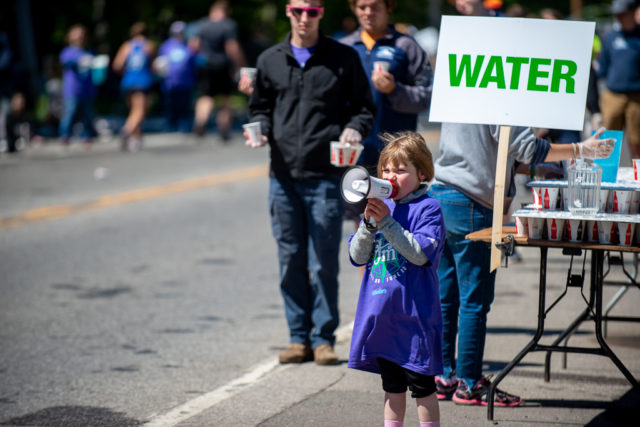Races proceed cautiously with return of community support
By Leah Etling
Events are taking a variety of approaches to volunteer assistance for the 2021 racing year. Some will dial back or forgo volunteer involvement to avoid health risks, while others have developed unique approaches for the uncharted territory of 2021.
With most events operating at a reduced participant capacity and seeking to limit person-to-person contact wherever possible, there are dual challenges in retaining volunteers – many are often local retirees – and keeping them safe and healthy during a mass participation event.
“It’s going to be important (for our industry) to reach out to our workforce to better understand what their concerns are as we continue to develop our mitigation and production plans for our events. We want to work with them to gain people’s confidence that we will have the proper resources and plans to create a safe and secure event for our constituents,” said Michael Nishi, Chief Operating Officer of Chicago Event Management (CEM). Nishi expects that CEM will have no issue filling volunteer spots this year, but final numbers and plans for the October Chicago Marathon are not yet complete.
“We know that this year will be a challenge when it comes to recruiting volunteers, and we need to be creative when it comes to identifying different groups. We will need to rely on volunteers, we just need to find new resources, such as non-profits, sports clubs, community groups, and others to fill the ranks,” Nishi said.
Here are two upcoming events that are closer to race day and have adjusted their typical plans for community volunteers.
Cutting Back in Canton
The Pro Football Hall of Fame Marathon in Canton, Ohio is taking a limited approach to volunteer labor for its 2021 live event of around 5,000 participants.
In a normal year, the race would have 600 volunteers. This year, they will make do with 176 on race weekend, set for April 30 to May 2 with a 5K, half marathon, marathon and relay event.
“I’ve reduced my sources of volunteers to what I consider to be known sources,” said Jim Chaney, Race Director. “We’ve gone from reaching out to the general public to very specifically known groups of people who already know each other and are likely already in contact, like businesses or ski clubs.” Such groups will be assigned together to volunteer stations.
Without an expo or an in-person post-race party at this year’s event, many volunteer roles were able to be eliminated. Chaney is also purchasing more signage, rather than using humans as directional beacons, and water stations will be bottles of water rather than cups, which drastically cuts down on volunteer needs.
HOF volunteers will be asked to wear masks while completing their tasks, but no temperature checks or COVID tests will be required. “All volunteers have to sign an online health waiver 48 hours before the event,” Chaney noted, just like the participating runners.
Leaning on Longevity at Grandma’s
But many races, long dependent on volunteer labor for registration, aid stations, security, course monitoring, swag distribution, food and more, simply can’t move forward without them, no matter how many runners are present.
Grandma’s Marathon in Duluth, Minn., expects to bring in up to 3,000 volunteers for its half capacity race weekend in June. That’s half of its typical volunteer total of around 6,000 helping hands. They’ll be supporting 4,000 runners at the sold-out 45th edition event.
“I know that some major metro marathons are turning away volunteers this year, but we will rely on our longtime volunteer leaders and team to get us through this year’s event with key positions filled,” said Alivia Nelson, Project Manager for Grandma’s Marathon. The point-to-point race is set for Saturday, June 19.
When we spoke for this article, Nelson wasn’t sure exactly how many volunteers she would need on race day. The state of Minnesota was still revising its guidelines around live events, so plans for traditionally volunteer-heavy spots like water stations were still in flux. Whether they’d use water bottles or cups for runner hydration, requiring varying people power, was not yet determined. Other roles, like security, will require the same number of boots on the ground as always, even with fewer runners.
With a reliable crew of volunteer leaders and returnees who come back year after year, most of those anticipated 3,000 volunteer spots will likely be filled by helpers who are familiar with the event. Returning volunteers include on-course entertainment for the first 18 miles of the marathon, which are rural, and a girls’ soccer team that combs all 26.2 miles of the course afterwards to pick up discarded trash.
“We were nervous about whether people would be comfortable coming back to volunteer this year, but people are telling us that they missed it last year and are looking forward to having that sense of normalcy,” Nelson said. Those who have volunteered at the event for more than 20 of its 45 years seem more than likely to come back, and it helps that most volunteers over age 65 have already had the chance to be vaccinated. But that won’t stop Nelson from recruiting new faces.
“Sometimes we talk about other races that don’t have to recruit, they just go through an application process. But here in Duluth, if I meet you in line at the grocery store, I will recruit you to volunteer for the marathon,” she said. There will be more of those in-aisle appeals heading into the 46th Grandma’s Marathon in 2022.
Although processes may look different in 2021, volunteers will continue to be vital to almost every race. Just like regaining runner confidence, bringing back volunteers will require careful planning, adjusted protocols and the allure of being part of a very special event.
